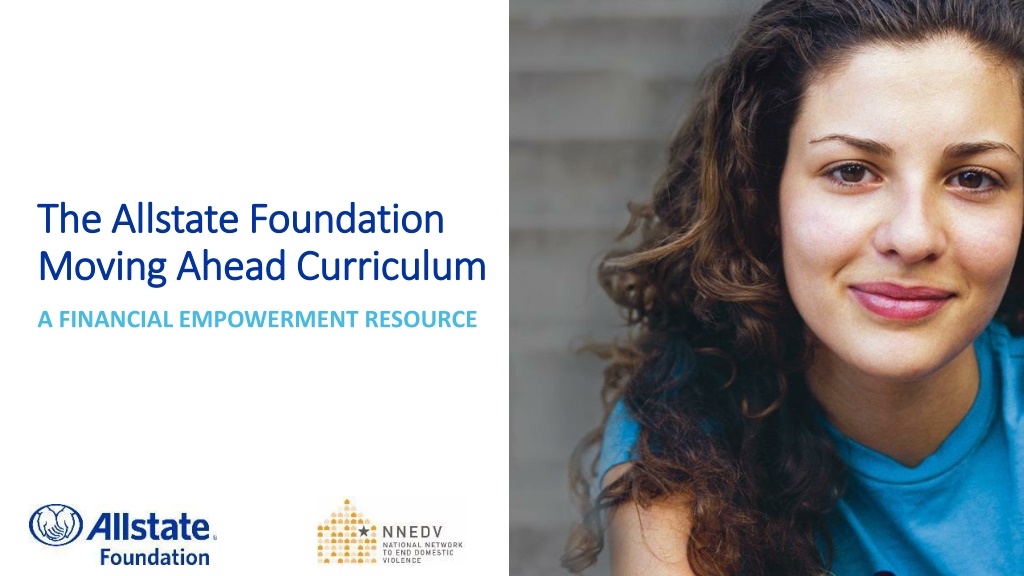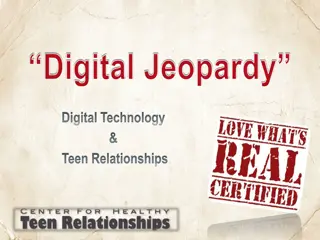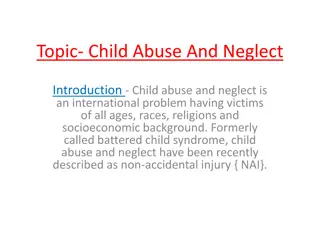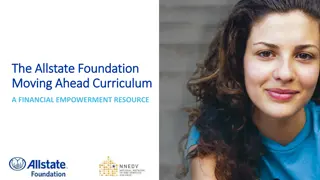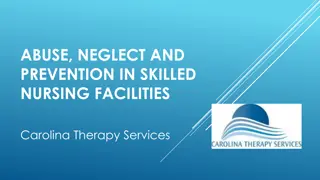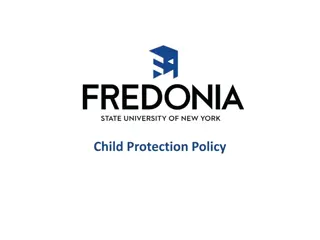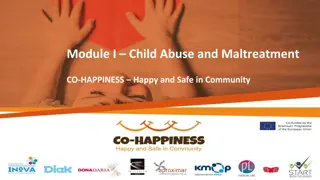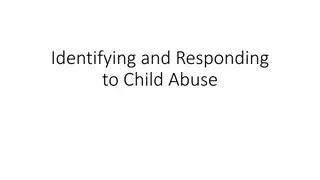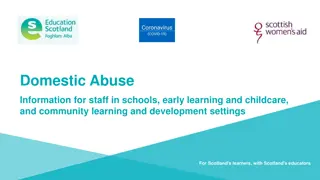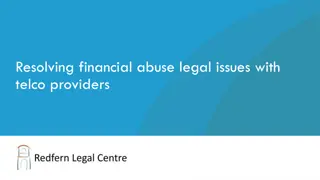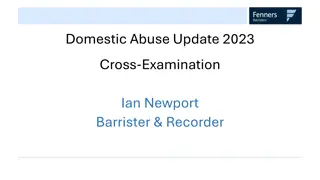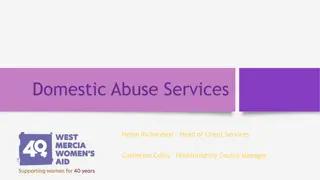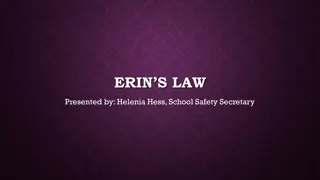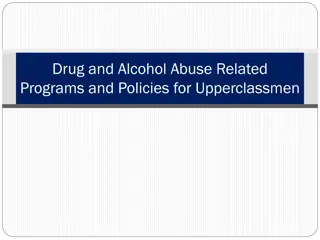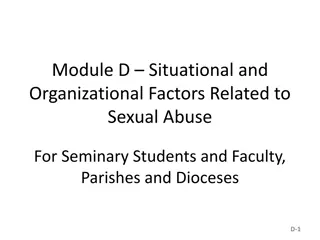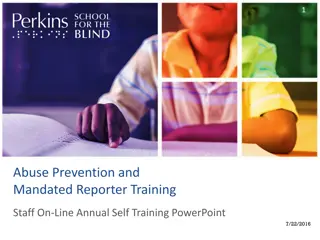Understanding Financial Abuse and Building Healthy Financial Relationships
Explore the impacts of financial abuse within relationships and learn about elements of a healthy financial partnership. Gain insights into recognizing signs of financial abuse, establishing financial safety, and fostering equality in decision-making. Understand how financial empowerment plays a vital role in creating sustainable relationships.
Download Presentation

Please find below an Image/Link to download the presentation.
The content on the website is provided AS IS for your information and personal use only. It may not be sold, licensed, or shared on other websites without obtaining consent from the author. Download presentation by click this link. If you encounter any issues during the download, it is possible that the publisher has removed the file from their server.
E N D
Presentation Transcript
The Allstate Foundation The Allstate Foundation Moving Ahead Curriculum Moving Ahead Curriculum A FINANCIAL EMPOWERMENT RESOURCE
MODULE 1 Understanding Financial Abuse Understanding Financial Abuse Keeping Safe and Starting Over Keeping Safe and Starting Over Key topics covered in this module include: Financially Abusive Relationships Financial Safety Planning Separation, Divorce and Child Support Disclosing Abuse Privacy Challenges
MODULE 1 Financially Abusive Relationships Financially Abusive Relationships
Reflection What did you learn about managing money? What messages were you given; overtly or covertly, spoken or observed? Were any of those messages specific to you, your gender, your culture, your faith? How have those messages impacted you today? What messages do you think survivors got from their abusive partners?
Elements of a Healthy Financial Relationship Both partners have access to financial information Although one may mange the day-to-day Negotiate to form joint financial goal Although they may have different values around money Both understand and respect that decision-making is equal Although one partner may earn more income or none at all Both partners have access to their money Without needing to ask permission or hide their spending Large or long-term financial decisions are made jointly Both have access to money and know where and how money is spent
What is Financial Abuse? VIOLENCE COERCION AND THREATS It s a form of Domestic Violence Often begins subtly and progresses over time Part of a pattern of abusive behavior, used to gain and maintain power & control within the relationship Often traps survivors 99% of survivors report experiencing some form of financial abuse INTIMDATION MALE PRIVILEGE EMOTIONAL ABUSE POWER AND CONTROL ECONOMIC ABUSE ISOLATION MINIMIZING, DENYING AND BLAMING USING CHILDREN VIOLENCE
Tactics of Financial Abuse Steal money from you or your family Force you to give access to your money or financial accounts Make all the household or financial decisions without consulting or including you Forbid you to work or attend educational opportunities Overuse credit cards or other lines of credit Refuse to pay bills or help support the family Prevent you from obtaining or using credit cards Withhold physical resources (Food, clothing, medications) Interfere with performance at work Frequent phone calls, emails, texts or visits
MODULE 1 Financial Safety Planning Financial Safety Planning
Financial Safety Planning Step One: Step Two: Step Three: Step Four: Think about your confidence level regarding finances Gain information about your current assets and liabilities Seek financial independence Begin saving money Assets what you own vs. Liabilities what you owe Open your own account or credit card Pay attention to the internal voices and where you got them from Save change from purchases Open a separate bank account Take pictures or make copies of any/all financial documents. Examples include: Marriage and birth certificates, bank and credit card statements, Social Security card Consider taking at least half of money in any jointly held accounts; track how funds were spent Divert raises or bonuses
Orders of Protection Court order signed by a judge or magistrate; varies by state Prohibits abusive party from threatening, stalking or harassing victim/s Orders of Protection can: Remove abuser from home Ban abuser from home and/or workplace Ban abuser from all contact Orders of Protection have different names. In your state, it might be called: Protective Order P.O. Restraining Order R.O. Protection From Abuse order - P.F.A.
Orders of Protection Orders of Protection can also offer economic relief: Child support Spousal support Mortgage/rent payment/s Temporary possession of property Car Clothing Reimbursement of medical expenses or property damage related to violence Lost wages Attorney s fees Moving expenses On WomensLaw.org, you can find what protections are available in your state. Note: Orders of Protection can t guarantee safety and are not the right choice for everyone.
Safety Planning New Housing Search Credit reports can be used to track someone's whereabouts Large property-management companies may run a credit check, which will show up on your credit report Consider supplying your own copy If you are getting a roommate, consider putting utilities in their name Technology Search internet for your name Be cautious with online applications, communication, emails and attachments Consider setting up a news alert Will notify you whenever your name, address or phone number are used on the internet
Safety Planning Workplace Safety If it is safe, available and appropriate, consider the following: Provide employer with copy of protection order and photo of your partner Ask security to escort you to and from the building Screen your telephone calls Save threatening e-mails, voice mails, letters and gifts Request workspace be moved to a more secure area, if possible
MODULE 1 Separation, Divorce Separation, Divorce and Child Support and Child Support
Separation, Divorce and Child Support Good legal advice is essential The right legal course of action is different for every person Gather as much data as possible before meeting with an attorney, such as: Past income tax return/s Pay stubs (both/all income) Employee benefits (both) Wish list of assets you would like to keep
Before Meeting with an Attorney Make a list of possessions in three categories Items that are yours Items that are your partner s Items you bought jointly or while married Determine your living expenses Include any expenses related to children Don t forget insurance coverage Division of assets and liabilities Home and/or property Savings and retirement accounts Debts
Pro Se Divorce Legal term = one appears in court on their own Responsible for their own legal representation May not be a safe choice; especially if custody of children is at stake Typically best suited when domestic violence is NOT a factor and when couples jointly agree to the conditions
Finding an Attorney Local Domestic Violence Program May be able to provide referral State Bar Association Attorney Referral Services Typically about $30 fee May allow you to talk with an attorney for the first half hour at no charge Clerk of the Court Officer of the court Can request an attorney referral list Law Schools May provide free legal counsel Legal Aid
Paying for an Attorney Most charge by the hour; typically based on experience For some procedures, they may offer a flat fee Wills Transfer of property However, since most divorces and/or custody cases are complicated, they typically require a retainer Single, up-front payment Plus an hourly rate once that s spent Arrangement should be written out and terms should be specific
Paying for an Attorney Contingency fee Provides the attorney a portion of any damages received by the client in a settlement Prepaid legal plan A participant (or employer) pays for future needed legal services (similar to a medical benefit plan) Pay a fixed amount each month or year for benefits to use when needed Typically provides advice and consultation by telephone as a basic service Legal aid offices Many local domestic violence programs have partnerships
Child Support A parent who does not have custody may be ordered to pay Can be voluntary or ordered by a judge or other agency Covers regular expenses involved in raising a child Can include medical, education and insurance costs For unmarried partners, paternity is not automatic May have to be proven May be a mixed blessing Can increase vulnerability to violence
Child Support You may be eligible for Child Support if: At least one child is under 18 Some states it s 21 or may have exceptions if the child has special needs You are the custodial parent or guardian Child support enforcement programs are run by the states People who have received assistance under the following, will be automatically referred for child support enforcement: TANF (Temporary Assistance to Needy Families) Medicaid Federally-assisted foster care programs
Public Assistance & Child Support If you received assistance under TANF, cooperation with the state and child support enforcements may be expected, i.e. Job search Appointments and meetings Disclosure of address Father s identity However, if doing so would put you or your children in danger and you can show good cause , cooperation can be waived if Make it more difficult to escape violence or increase risk of further violence Unfairly penalize because of domestic violence In cases of rape or incest
MODULE 1 Disclosing Abuse Disclosing Abuse & Privacy Challenges & Privacy Challenges
Disclosing Abuse Before disclosing, carefully consider the potential consequences People may be insensitive and victim- blame Could impact housing, employment or access to services May lose or reduce public assistance Could result in referral to child protective agency Consult with an advocate and/or attorney to know your rights
Privacy Protection Considerations Address confidentiality program (if your state has one) or getting a P.O. Box address Block electronic access to your Social Security number Place new or additional password or authentication on your accounts Try to reduce the number of accounts in your name
Identity Theft Someone acquires and accesses existing account(s) Example: steal existing credit or debit card to make purchases Application Fraud Someone uses your personal data to take out a new line of credit in your name Abusers often commit identity theft to track and ruin survivors financially
Personal Data Vulnerabilities Digging through trash bins for documents containing personal information Date of Birth Social Security Number (SSN) Stealing mail Newly issued credit cards Pre-approved credit offers Financial, insurance and benefits statements Tax information Accessing your credit report Posing as you, an employer, loan officer or landlord Using the internet or paying an information broker Can access date of birth, information about family members, phone numbers and your last known address
Be Data Savvy Don t provide you SSN, address, email or phone number unless you know it s absolutely necessary Learn what information about you is already available publicly Google search Limit the information your share on the internet and social media Shred everything! Opt-In to Opt-Out Beware of requests for personal information or phishing Change password and PINs Include number and symbols
The Allstate Foundation The Allstate Foundation Moving Ahead Curriculum Moving Ahead Curriculum A FINANCIAL EMPOWERMENT RESOURCE
